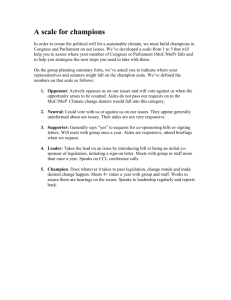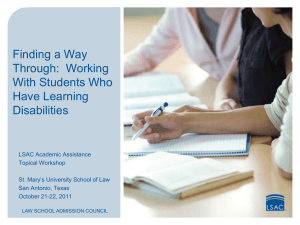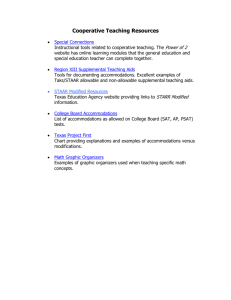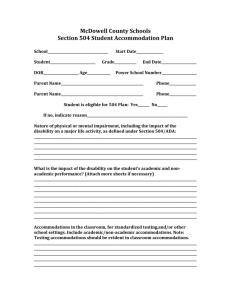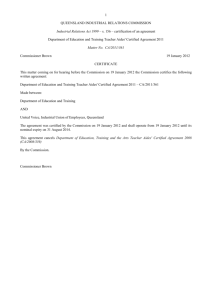“Programming for Children with Social, Emotional, and Behavioral
advertisement
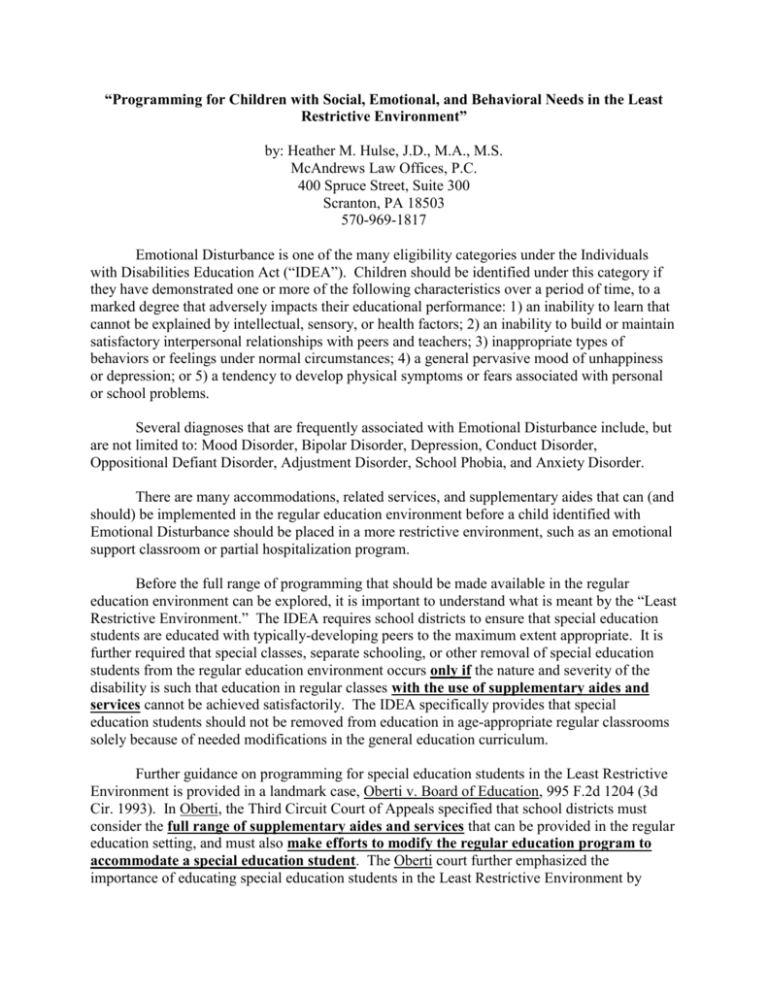
“Programming for Children with Social, Emotional, and Behavioral Needs in the Least Restrictive Environment” by: Heather M. Hulse, J.D., M.A., M.S. McAndrews Law Offices, P.C. 400 Spruce Street, Suite 300 Scranton, PA 18503 570-969-1817 Emotional Disturbance is one of the many eligibility categories under the Individuals with Disabilities Education Act (“IDEA”). Children should be identified under this category if they have demonstrated one or more of the following characteristics over a period of time, to a marked degree that adversely impacts their educational performance: 1) an inability to learn that cannot be explained by intellectual, sensory, or health factors; 2) an inability to build or maintain satisfactory interpersonal relationships with peers and teachers; 3) inappropriate types of behaviors or feelings under normal circumstances; 4) a general pervasive mood of unhappiness or depression; or 5) a tendency to develop physical symptoms or fears associated with personal or school problems. Several diagnoses that are frequently associated with Emotional Disturbance include, but are not limited to: Mood Disorder, Bipolar Disorder, Depression, Conduct Disorder, Oppositional Defiant Disorder, Adjustment Disorder, School Phobia, and Anxiety Disorder. There are many accommodations, related services, and supplementary aides that can (and should) be implemented in the regular education environment before a child identified with Emotional Disturbance should be placed in a more restrictive environment, such as an emotional support classroom or partial hospitalization program. Before the full range of programming that should be made available in the regular education environment can be explored, it is important to understand what is meant by the “Least Restrictive Environment.” The IDEA requires school districts to ensure that special education students are educated with typically-developing peers to the maximum extent appropriate. It is further required that special classes, separate schooling, or other removal of special education students from the regular education environment occurs only if the nature and severity of the disability is such that education in regular classes with the use of supplementary aides and services cannot be achieved satisfactorily. The IDEA specifically provides that special education students should not be removed from education in age-appropriate regular classrooms solely because of needed modifications in the general education curriculum. Further guidance on programming for special education students in the Least Restrictive Environment is provided in a landmark case, Oberti v. Board of Education, 995 F.2d 1204 (3d Cir. 1993). In Oberti, the Third Circuit Court of Appeals specified that school districts must consider the full range of supplementary aides and services that can be provided in the regular education setting, and must also make efforts to modify the regular education program to accommodate a special education student. The Oberti court further emphasized the importance of educating special education students in the Least Restrictive Environment by clarifying that even when a special education student might make greater academic progress in a separate class or school, excluding that child from a regular classroom environment may not be appropriate. There are a variety of accommodations and supplementary aides that can be provided to a special education student with Emotional Disturbance in a regular education setting. Accommodations must be reasonably calculated to afford meaningful educational progress. It should be noted that educational progress includes social, emotional, and behavioral progress. Examples of accommodations for special education students with social, emotional, and behavioral needs include (but are not limited to): a one-on-one aide; a Behavior Specialist to comprehensively analyze the student’s behavior and develop a positive behavior support plan; consistent verbal prompts to make good choices and reinforce positive choices made – consistently catch good behaviors; student should be provided with choices wherever possible, especially in situations that may create anxiety; directions should be chunked into understandable, small, concise steps that student can demonstrate an understanding of, by using his/her own words to retell them to a teacher or aide; if student identifies a problem, he/she should have the opportunity to process those issues with a supportive school member. This person should be someone student relates well to (a back-up person should be identified in case the first person is not available) documentation of what caused the problem and how it was resolved; opportunities for breaks; teachers or aide should monitor when a break may be needed and discreetly suggest it to student verbally or through a pre-determined secret signal; visual, verbal or non verbal prompting to remain on and complete tasks and to refocus; rewards (something that is reinforcing for student) for making good choices; dealing with challenging behaviors should be done calmly, with firm restatement that often needs to be repeated several times. When dealing with rage and anger, staff should stay calm, validate feelings, and reassure student everything is okay and allow student to talk calmly when he/she is ready; assignments should be reduced if it is too overwhelming; and student’s IEP should be provided to and comprehensively discussed with all of student’s teachers. IDEA also provides various Related Services that must be offered where appropriate in order to afford a student meaningful educational progress. These services should be based on peer-reviewed research. Thus, a social skills group of peers should utilize research-based social skills programming to address the student’s specific needs, such as coping skills and peer interactions. Examples of Related Services that can be offered to special education students with social, emotional, and behavioral difficulties include (but are not limited to): psychological services; counseling services, including anger management; social skills training; school health services; social work services in schools; parent counseling and training; and medical services for diagnostic or evaluation purposes. In summary, school districts must offer the full range of aides, accommodations, and services in a regular education environment to students with Emotional Disturbance. Many of these students can make meaningful educational progress in such a setting with appropriate aides, accommodations, and services. Referring a student to a more restrictive placement, such as a full-time emotional support classroom or a partial hospitalization program should be considered only after the full range of appropriate aides, accommodations, and services have been provided and have not been effective in promoting meaningful educational progress.


![See our handout on Classroom Access Personnel [doc]](http://s3.studylib.net/store/data/007033314_1-354ad15753436b5c05a8b4105c194a96-300x300.png)
